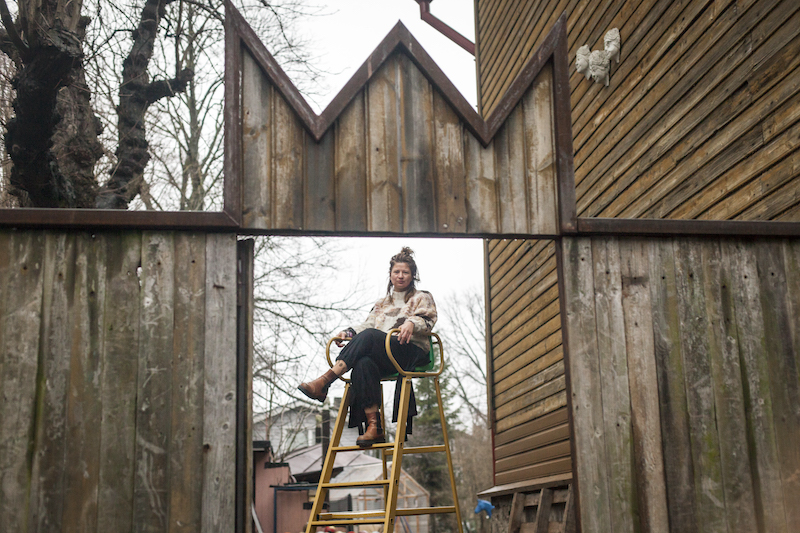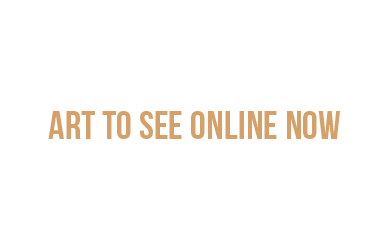by Adela Lovric, studio photos by Alana Proosa // Apr. 11, 2025
When I arrive at the Flo Kasearu House Museum—a place that is equal parts home, studio, institution and conceptual (as well as literal) playground—Flo Kasearu herself is perched atop a tall lifeguard chair in the backyard, striking an authoritative pose for the photographer. There’s a crown installed on the yard gate, which aligns with the top of her head in the photo frame. The gesture is neither subtle nor accidental. This is her queendom. Flo Kasearu: artist, museum director, curator, landlord, head of household and undisputed queen of this DIY institution she built to honor her own work. Founding a museum to herself, in her own house, in her 20s—out of context, it might look like a delusional act of self-mythologizing gone off the rails. Like those lenticular postcards that shift between images as you tilt them, her sunny, almost childlike demeanor flickers through the formidable persona she’s crafted, assuring us it’s all just part of her ongoing commitment to the bit.

She shows us a thick book from ‘Flo’s Restrospective,’ her 2022 exhibition at Kunsthalle Recklinghausen. “[A] retrospective is something that you usually do when you’re 70 or 80. But I did it already, as I was given this big space.” Flipping authority into farce and questioning power dynamics is a significant portion of her work. A particularly fun example is her 2021 piece ‘Disorder Patrol,’ initially presented at contemporary art festival Steirischer Herbst. She tackled the question of public space and its supposedly necessary safety measures with a performative intervention in the streets of Graz. Wearing embellished uniforms with headgear oversized to a comical extreme, performers sowed productive disorder across the city they supposedly patrolled. COVID-era tapes blocking public spaces from use were replaced with colorful gymnastics ribbons. Even with obvious elements of the absurd, not everyone understood that this was not actually one of the new law enforcement agencies, which had proliferated and become increasingly dominant in the city.

Kasearu’s artistic practice extends in many directions, not sparing her personal life. As she guides us through the museum, the line between public and private grows increasingly porous, well beyond the simple fact that this is her real home, shared with her partner and two children. Here, ordinary problems often come with unusually creative solutions, some of which end up as part of the museum display. Case in point: near the main entrance, Kasearu displays puppet drawings made by children who lived in the house before her, which she discovered during renovations. They now represent the current tenants—also artists—who rent out the spare apartments in the house. “If there’s a delay in paying their bills, I put their picture here. It’s meant to be a motivation to pay on time,” she explains. “But, to be honest, it’s not really working because the drawings are beautiful and kind of abstract. So the shame board has become a fame board.”
The house itself has a rich history, and Kasearu eagerly recounts its timeline while pointing to portraits of ancestors. Built around 1910 by her great-grandparents, it’s an example of Lender architecture: modest wooden homes designed to make urban homeownership possible for working-class Estonians. Her family was displaced during the Soviet occupation and weren’t able to reclaim the property until 1991. It took 20 years until they could come back to the house, and Flo was the one who was finally able to claim it. By then, the place was looted and neglected. But instead of just renovating, Kasearu turned the process into a series of art projects.

The idea for the Flo Kasearu House Museum was initially meant to be a two-week project as part of her MA thesis. She was intrigued by the concept of a house museum, typically established only after its subject is already dead, but she couldn’t accept the idea of fame arriving that late. So she created the museum herself. It officially opened on April 24th, 2013—Kasearu’s birthday. “Usually, house museums are connected with personal dates [related to the one] to whom it is dedicated,” she says. “It was also that I didn’t want to get older, so I thought of it like a restart. Now I celebrate that the museum [will be] 12 years old this year.” Since then, the museum hasn’t stopped evolving: there’s a gift shop and cafeteria, a children’s corner, a museum library inside the restroom, an archive, a sauna and art spilling into every corner—from attic to basement to backyard.

In 2014, while preparing for an exhibition at Zachęta National Gallery of Art in Poland, Kasearu struck up a conversation with a friendly security guard. The exchange sparked an idea. “I’m doing everything myself here,” she says. “I’m the artist, the security guard, the cleaner, the bookkeeper, the producer. It’s almost like a one-person museum.” She invited the guard to take over her security role in Tallinn for a week. Funded by his Polish institution, he came to guard the fence that once connected her yard to the neighbors’. “There was a real gap,” she explains. “Thieves could come in, people without tickets. Or, if you zoom out, it could be like the gap between Estonia and Russia. Estonia is now investing a lot into building a proper border because people go missing and there’s human trafficking.” For Kasearu, the piece became about “holes in the system,” and the question of whether they should be guarded—or whether, perhaps, some breaches are normal.
The museum’s current display, which occasionally rotates to include new works, is threaded with the theme of domesticity. Kasearu tells us about her mother, who has been running a women’s shelter in Pärnu for about as long as she has been doing projects in the house. With at least one in five women having experienced it, domestic violence has become a major topic in Estonia—unlike during the Soviet era, when it wasn’t discussed at all, as whatever happened at home was considered strictly private. Inspired by her mother’s work and the women’s stories, Kasearu created ‘Festival of the Shelter’ (2018), a site-specific project inside the Pärnu shelter, which was accessible only to its residents and staff. Two years later, ‘Castlings’ was released—a book Kasearu co-created with writer Jan Kaus, based on an idea from the women in Pärnu. It served as a kind of emotional reparation: Kasearu contributed illustrations to Kaus’s fairy tales, each with a happy ending for women who rarely receive one in court.

The wall leading upstairs is lined with a series of graphite drawings of the house in various catastrophic scenarios—Kasearu’s attempt to process her worries. “It’s like art therapy,” she says. “When I have a fear, I draw it on paper and share it with others. It’s an old wooden house. Now there are floods.” The list of terrors goes on: “Tornado. 9/11. Volcano. Ice age. Bomb. Fire. End of the world.” From the upper floor, a voice persistently calls the artist’s name, matching the doomsday anxiety with its own sense of urgency. It’s a video featuring her late grandmother, who, in her old age, lost her sight and relied on the help of her family. “It reminded me of when I was young,” Kasearu recalls. “She was always cooking, and when the food was ready and I was outside playing, she’d scream ‘Flo’ from the third floor, calling me to come eat. Now that she’s no longer with us, she’s in this closet, calling me again.”
After a brief visit to the attic where the museum collection is stored—including the remains of ‘Violence Grows in Silence’ (2021), and installation of withered plants tied to the theme of domestic violence—Kasearu switches the playful persona back on, showing us the staircase she converted into a slide. Moments later, we’re sloshing through the flooded basement. “We didn’t have a river before, but when the next house was built, we suddenly got one,” she remarks, comparing the site to Venice in her consistently wry performance of art world gravitas. Now clearly out of function, the basement “used to have two factory lines”—meaning, it quite literally served as an art production space. But the setup doubles as a critique of the creative industries’ obsession with churning out beautiful things, often with little concern for real substance.

On the bright side, the entirety of the property—with its spread-out backyard dotted with artworks—is Kasearu’s studio. However, it’s an endless work-in-progress, paired with occasional tug-of-war with the next-door neighbors. While the flooded basement clearly needs serious repair, her frustrations go beyond that. “Now that the neighbors are higher,” she says, “they’re looking from above into my garden.” That sense of surveillance and encroachment became a central part of her recently opened exhibition ‘BANANA – Build Absolutely Nothing Anywhere Near Anyone’ at Kai Art Center, a response to unchecked development, real estate expansion and the NIMBY (Not In My Backyard) phenomenon. NIMBY attitudes typically frame development as disruptive or harmful—justified or not—while YIMBY (Yes in My Backyard) proponents tend to champion it as a social good, though that optimism isn’t always warranted either. She used an old section of her fence—once deemed too shabby and replaced by neighbors—to recreate her backyard in the exhibition and explore boundaries between public and private. “It’s also about how all of Estonia will soon be covered with wind turbines—it’s a huge topic. We need new energy sources after disconnecting from Russia.”

For this exhibition, Kasearu made a rare move: she worked off-site, in an external studio, where she could produce larger sculptural pieces—assisted, of course, by her partner, whom she insists on referring to as her “technical director.” There, she also created a new series of paintings. The shift in the setting seems like a welcome breather. After all, the Flo Kasearu House Museum is her actual home, her family’s living space and a never-ending performance. With Kasearu cast in nearly every role, the lines blur completely. Even the most committed artist might occasionally feel the weight of such an all-encompassing project where regular domestic life, dressed up in layers of irony and institutional critique, becomes part of a never-ending show.
Artist Info
Kai Art Center
Flo Kasearu: ‘BANANA – Build Absolutely Nothing Anywhere Near Anyone’
Exhibition: Mar. 22-Aug. 3, 2025
kai.center
Peetri 12, 10415 Tallinn, Estonia, click here for map





















